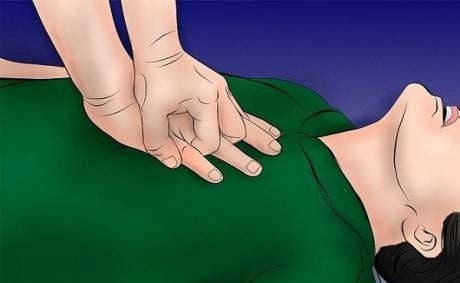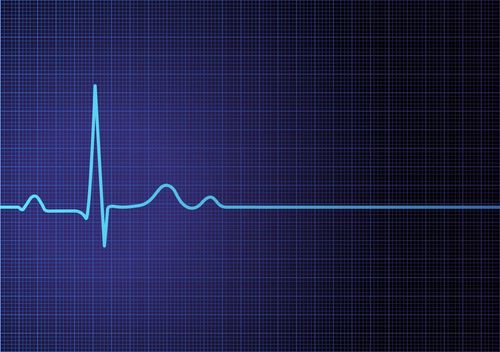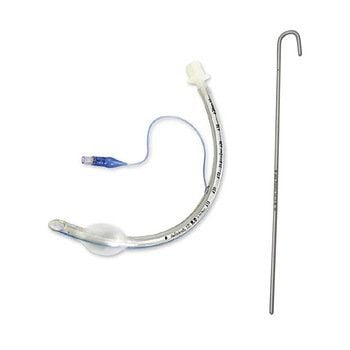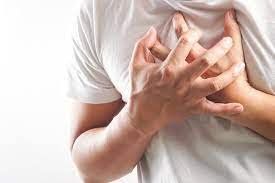This is an automatically translated article.
The article was professionally consulted by Master, Doctor Tong Van Hoan - Emergency Medicine Doctor - Emergency Department - Vinmec Danang International HospitalUpdated AHA Guidelines for Cardiopulmonary Resuscitation (CPR) and Emergency Cardiovascular Care (ECC) 2015 based on an international evidence review process of 250 evidence reviewers from 39 countries ECC guidelines 2015
1. Basic cardiopulmonary resuscitation in adults and the quality of cardiopulmonary resuscitation
1.1. Immediate recognition and action of the emergency system: (updated 2015) Emergency responders need to determine if the victim is unresponsive and breathing normally after learning the necessary information about the site of the incident. out incident. If the patient is unresponsive with no breathing or normal breathing, the ER should consider the patient in cardiac arrest (Class IIa, LOE C-LD).
Persons presenting to the emergency department should be trained in unresponsiveness with abnormal breathing and yawns across a range of clinical manifestations and descriptions (Class I, LOE C).
1.2. Early CPR: (updated 2015) Similar to the 2010 recommendations, it may be reasonable for rescuers to initiate CPR with chest compressions (Class IIb, LOE C). The properties of effective chest compressions are described in the separate section on basic resuscitation skills (BLS). As in the 2010 sequence, once chest compressions have been initiated, a trained rescuer provides mouth-to-mouth-mask or respirator with air bags to deliver oxygen and ventilate. Recommendations regarding the duration of each breath and the need for increased compressions are not included in this recommendation.
1.3. Untrained rescuers: (updated 2015) Untrained paramedics should perform CPR with chest compressions only, with or without the assistance of a dispatcher ( Class I, LOE C). Rescuers should continue with chest compressions only until an automated external defibrillator (AED) or trained rescuer is available (Class I, LOE C).
1.4. Trained amateur rescuers: (updated 2015) All amateur rescuers should at a minimum perform chest compressions on a victim in cardiac arrest (Class I, LOE C). In addition, if a trained rescuer can perform CPR, he or she should give CPR at a rate of 30 compressions for every 2 breaths. Rescuers should continue CPR until an AED is available to use or paramedics arrive to receive the casualty or the victim begins to move (Class I, LOE C).

1.5. Healthcare professionals: (updated 2015) Compression and ventilation performed by a healthcare professional are reasonable for all patients with cardiac arrest from cardiac or noncardiac causes (Class IIa, LOE C). In addition, paramedics arrange rescue operations to be most appropriate for the cause of cardiac arrest. For example, if only one health care provider sees a teenager suddenly having a stroke, the healthcare provider assumes that the victim has suffered sudden cardiac arrhythmia and calls for help, if there is an AED nearby, return the victim to the AED and then perform CPR.
1.6. Delayed Ventilation: (new 2015) For witness out-of-hospital cardiac arrest (OHCA) with a shockable heartbeat, it may be reasonable to respond to emergency medical services (EMS) Priority-based multi-layering will delay positive pressure ventilation using a strategy of up to 3 cycles of 200 consecutive chest compressions with passive oxygen delivery and airway support (Class IIb, LOE C- LD).
1.7. Safety Verification: (new 2015) For patients with known or suspected opioid addiction (opiates and derivatives) who are unresponsive, breathing irregularly but with pulse, it makes sense for rescuers to not appropriately trained BLS professionals and practitioners to administer naloxone intramuscularly or intranasally in addition to performing standard BLS care (Class IIa, LOE C). In patients with cardiac arrest, drug administration is ineffective without simultaneous cardiac compressions to allow the drug to reach tissues, so naloxone should be considered after initiation of CPR if an opioid overdose is highly suspected (Class IIb, LOE). C). Opioid overdose response training with or without naloxone delivery may be considered for individuals at risk of opioid overdose under any circumstances (Class IIa, LOE C).
1.8. Compression position: (unchanged 2015) As recommended in 2010, position of the hand for chest compressions in the lower half of the sternum for adults in cardiac arrest (Class IIa, LOE C).
1.9. Compression Rate: (Updated 2015 ) In an adult cardiac arrest victim, it is reasonable for rescuers to perform chest compressions at a rate of 100 – 120 beats/min (Class IIa, LOE C).
1.10. Amplitude of compressions: (updated 2015) During manual CPR, rescuers should perform chest compressions with an amplitude of at least 2 inches (5cm) for the average adult, avoiding too large (large) compression amplitudes. more than 2.4 inches-6cm) (Class I, LOE C).
1.11. Chest Rebound: (Updated 2015) It is reasonable for rescuers to avoid chest compressions between chest compressions for complete chest wall reverberation in adults in cardiac arrest (Class IIa, LOE C).
1.12. Minimize interruptions in compressions: (new 2015) In adults with cardiac arrest, the interval for compressions before or after the shock should be as short as possible (Class I, LOE C). For adults in cardiac arrest undergoing CPR without an elevated airway, chest compressions can be stopped for at least 10 seconds to give 2 breaths (Class IIa, LOE C). In adults with CPR in cardiac arrest without a protected airway, performing CPR with the goal of a compression ratio as high as possible, with a goal of at least 60% may be reasonable (Class IIb, LOE). C).
1.13. Compression-ventilation ratio: (unchanged in 2015) As recommended in 2010, rescuers perform chest compressions-breathing at a ratio of 30:2 for adults in cardiac arrest (Class IIa, LOE C) .
1.14. Non-specialist: CPR with chest compressions only versus conventional CPR (compression with rescue breaths) The following recommendation is relevant for 2010 regarding CPR non-specialists. Persons presenting to the emergency room CPR only for adults with suspected OHCA (Class I, LOE C). For the untrained rescuer, compression-only CPR is a reasonable alternative to conventional CPR in patients (Class IIa, LOE C). For the trained non-specialist rescuer, performing additional ventilation to chest compressions is reasonable for adults in cardiac arrest (Class IIa, LOE C).

1.15. Rescue ventilation When the patient does not have an elevated airway in place, give 30 compressions and 2 ventilations during CPR. Ventilate for about 1 second at pause of chest compressions (Class IIa, LOE C-LD)
1.16. Ventilate with an elevated airway If the patient has an elevated airway in place, ventilate once every 6 seconds (10 breaths/min) while performing continuous chest compressions (Class IIb, LOE C-LD)
1.17. Passive versus positive pressure oxygen in CPR: (new 2015) Routine passive ventilation in CPR for adults is not recommended for routine use (Class IIb, LOE C). However, in the EMS system, a set of care including continuous chest compressions and passive ventilation can be considered part of it (Class IIb, LOE C).
1.18. CPR before defibrillation: (updated 2015) For witnessed adult cardiac arrest when an AED is immediately available, it is reasonable to use a defibrillator as soon as possible (Class IIa, LOE C). In adults whose cardiac arrest is not being monitored or where an AED is not immediately available, it is reasonable to initiate CPR while finding and using a defibrillator, performing defibrillation as soon as the device is ready for use, if available. (Class IIa, LOE B).
1.19. Rhythm analysis in compressions: (new 2015) There is insufficient evidence to recommend the use of ECG rhythm analysis noise filtering procedures in CPR. This can be considered as part of a study, or if the EMS system, hospital or other institution already has procedures in place to filter out ECG analysis noise in the resuscitation protocol (Class IIb, LOE C-EO). .
1.20. Timing to check rhythm: (updated 2015) Immediate continuation of chest compressions after cardioversion is reasonable for adults in cardiac arrest under any circumstances (Class IIb, LOE C).
Use of audio-visual feedback devices is reasonable in CPR to maximize the effectiveness of CPR (Class IIb, LOE B).
2. Advanced Cardiovascular Resuscitation in Adults
2.1. Dose of oxygen in CPR: (updated 2015) When supplemental oxygen is available, the maximal fractional oxygen fraction (FiO2) can be used during CPR (Class IIb, LOE C-EO).
2.2. Monitoring of physiological parameters during CPR: (updated 2015) Although there are no clinical studies to examine the improvement of physiological parameters during CPR, physiological parameters are used (quantitative EtCO2 waveform gasgram, diastolic relaxation time, arterial blood pressure monitoring, central venous oxygen saturation) when feasible to monitor and optimize CPR quality, guide motor therapy pulse and reproducibility of spontaneous circulation (ROSC) detection (Class IIb, LOE C-EO).
Previously, it was recommended to specify target values of physiological parameters. However, because the exact target of parameters during CPR has not been established, these indicators are not specified in the 2015 recommendation.
2.3. Echocardiography in cardiac arrest: (updated 2015) Ultrasound (cardiac or noncardiac) may be considered during the management of cardiac arrest, although the benefit has not been well established (Class IIb, LOE C-EO).
If the sonographer is available and the use of ultrasound does not interfere with the standard cardiac arrest regimen, ultrasound can be considered a standard adjunct to the evaluation of the patient (Class IIb, LOE C- EO).
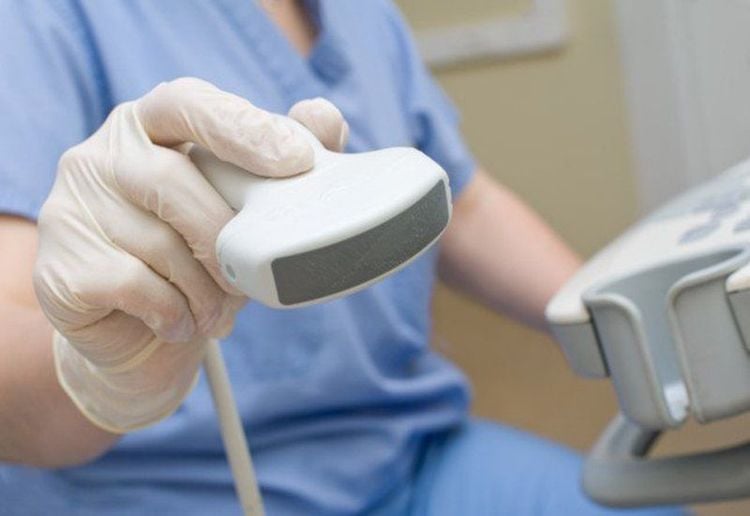
2.4. Advanced Airway Site Selection: (updated 2015) Masks with air bags or enhanced airways can be used to provide oxygen and ventilation during in-hospital and out-of-hospital CPR (Class IIb) , LOE CLD).For trained medical personnel, an upper oropharyngeal airway (SGA) or endotracheal tube (ET) device may be used as an enhanced airway device. initially during CPR (Class IIb, LOE C-LD).
2.5. Evaluation of endotracheal tube position: (updated 2015) Continuous waveform EtCO2 is recommended in addition to clinical evaluation as the most reliable method for accurate identification and monitoring of endotracheal tube position. trachea (Class I, LOE C-LD).
If continuous waveform EtCO2 is not available, a non-waveform CO2 meter, esophageal detector, or ultrasound used by experienced personnel is a reasonable choice (Class IIa, LOE C- LD).
2.6. Post-ventilation ventilation: (2015 update) Once an elevated airway is established, it is reasonable to perform ventilation once every 6 seconds (10 ventilations/min) while still performing Continuous chest compressions (Class IIb, LOE C-LD).
2.7. Defibrillation strategy for ventricular fibrillation or pulseless ventricular tachycardia: success in first shock: (updated 2015) Defibrillators (2 phase or single phase) are recommended for management of atrial or ventricular arrhythmias. (Class I, LOE B-NR).
Based on greater success in arrhythmia termination, 2-phase (synchronous or asynchronous) defibrillators are preferred over single-phase machines for the treatment of atrial and ventricular arrhythmias (Class IIa, LOE B) ).
When there is no convincing evidence that a high-pass biphasic waveform machine is superior to another for ventricular fibrillation, it is reasonable to use the power level according to the manufacturer's instructions for the first shock. If this is not known, defibrillation with maximum energy is considered. (Class IIb, LOE C-LD).
2.8. Defibrillation strategy for ventricular fibrillation or pulseless ventricular tachycardia: energy levels for the next shock: (updated 2015) Choose a fixed rather than incremental energy level for subsequent shocks based on the guidelines of manufacturer is reasonable (Class IIa, LOE C-LD). If a stepwise energy level defibrillator is used, using a higher energy level for the second and subsequent shocks may be considered (Class IIb, LOE C-LD).
2.9. Defibrillation strategies for ventricular fibrillation or pulseless ventricular tachycardia: single shock versus multiple shocks on top of one another: (updated 2015) The single shock strategy (as opposed to multiple superimposed shocks) is reasonable for defibrillation (Class IIa, LOE B-NR).
2.10. Antiarrhythmic drugs during and immediately after cardiac arrest: antiarrhythmic drug therapy for refractory ventricular fibrillation or pulseless ventricular tachycardia: (2015 update) Amiodarone is considered for use in ventricular fibrillation or unresponsive pulseless ventricular tachycardia response to CPR, defibrillation, and vasoconstriction (Class IIb, LOE B-R).
Lidocaine may be an alternative to amiodarone in ventricular fibrillation or pulseless ventricular tachycardia unresponsive to CPR, defibrillation, and vasoconstriction (Class IIb, LOE C-LD).
Routine magnesium is not recommended in adult ventricular fibrillation or pulseless ventricular tachycardia (Class III).
No antiarrhythmic drug has been shown to improve survival and neurological outcome after cardiac arrest due to ventricular fibrillation or pulseless ventricular tachycardia. Accordingly, recommendations for the use of antiarrhythmic agents in cardiac arrest are based primarily on short-term benefit until survival efficacy and neurological outcome studies are available.
2.11. Antiarrhythmic drugs during and immediately after cardiac arrest: Antiarrhythmic drugs after resuscitation: (new 2015) There is insufficient evidence for the use of Lidocaine after cardiac arrest. However, consideration may be given to initiating or continuing Lidocaine immediately after ROSC from cardiac arrest due to ventricular fibrillation or pulseless ventricular tachycardia (Class IIb, LOE C-LD).
There is insufficient evidence for the routine use of β-blockers after cardiac arrest. However, starting or continuing an intravenous or oral β-blocker may be considered early after admission for cardiac arrest due to ventricular fibrillation or pulseless ventricular tachycardia (Class IIb, LOE C).
There is insufficient evidence to recommend or against initiation or continuation of other antiarrhythmic agents in the presence of ROSC after cardiac arrest.
2.12. Vasopressors in Cardiac Arrest: Standard Dose of Epinephrine: (Updated 2015) A standard dose of Epinephrine (1mg every 3-5 minutes) may be reasonable for patients in cardiac arrest (Class IIb, LOE B-R).
2.13. Vasopressors in cardiac arrest: (2015 update) High-dose Epinephrine is not recommended for use in cardiac arrest (Class III).
Vasopressin is not a superior alternative to standard-dose epinephrine in cardiac arrest (Class IIb, LOE B-R).
Vasopressin plus epinephrine is not preferred as a substitute for standard dose epinephrine in cardiac arrest (Class IIb, LOE B-R).
Administer epinephrine as soon as reasonably practicable after the onset of non-shockable initial cardiac arrest (Class IIb, LOE C).
2.14. Steroids: (updated 2015) There are no data recommending or against the use of steroids alone in patients with in-hospital cardiac arrest (IHCA).
For IHCA, Vasopressin, Epinephrine, Methylprednisolone in cardiac arrest and Hydrocortisone after cardiac arrest according to a study by Mentzelopoulos may be considered. However, further studies are needed before the routine use of this treatment strategy is recommended (Class IIb, LOE C-LD). -For OHCA, use of steroids in CPR is uncertain (Class IIb, LOE C-LD).
2.15. Prognosis in CPR with EtCO2: (new 2015) In intubated patients, failure to achieve a value greater than 10 mmHg with EtCO2 waveform after 20 minutes of CPR can be considered part of the approach. Multimodal approach to deciding when to end resuscitation efforts but should not be used alone (Class IIb, LOE C-LD). The above recommendation is made regarding EtCO2 in intubated patients, as the studies reviewed included only those who were already intubated.
In non-intubated patients, a specific EtCO2 cutoff at any time during CPR should not be used as a marker to terminate resuscitation (Class III).
2.16. Extracorporeal cardiopulmonary resuscitation (ECPR): (new 2015) There is insufficient evidence to recommend routine use of ECPR in patients with cardiac arrest. Where available, ECPR may be considered for selected patients with cardiac arrest whose cause is suspected to be potentially reversible for a limited time with mechanical cardiopulmonary support. Class IIb, LOE CLD).

3. Special cases in cardiopulmonary resuscitation
3.1. Cardiac arrest associated with pulmonary embolism Advanced resuscitation variable: confirmed pulmonary embolism
2015-new and updated recommendations:
In patients for whom pulmonary embolism is confirmed as a predisposing factor Promoting cardiac arrest, thrombolysis, surgical thrombectomy, and mechanical thrombectomy are reasonable emergency treatment options (Class IIa, LOE C-LD). No comparative data are available to recommend one strategy over another. Patient location, local intervention options, and patient factors (including contraindications to thrombolysis) are factors to be considered. Thrombolysis may be beneficial even when chest compressions are performed (Class IIa, LOE CLD). Modified Advanced Resuscitation: Suspected pulmonary embolism.
Thrombolysis may be considered when cardiac arrest is suspected to be due to pulmonary embolism (Class IIb, LOE C-LD). There is no consensus on indication criteria (eg, risk factors, signs, or symptoms constituting a suspected pulmonary embolism), timing of thrombolysis, medication, or dose in this setting. There are insufficient data on surgical and mechanical thrombectomy to evaluate the effectiveness of these methods in cardiac arrest associated with suspected but undefined pulmonary embolism. 3.2. Cardiac arrest during percutaneous coronary interventions New and updated 2015 Recommendations
Advanced Modified Resuscitation
Mechanical cardiopulmonary resuscitation devices may be reasonable for CPR for patients in cardiac arrest during PCI (Class IIb, LOE C-EO). Extracorporeal cardiopulmonary resuscitation (ECPR) may be reasonable as a salvage treatment when initial treatment failure due to cardiac arrest occurs during PCI (Class IIb, LOE C-LD). Because patients may remain in need of long-term ECPR support without the possibility of recovery, practical and ethical issues should be considered in determining which cardiac arrest patients should receive ECPR support. Facility guidelines should include appropriate patient selection for the use of mechanical assist devices to ensure that these devices are used as a bridge to rehabilitation, surgery, or transplantation. , or use another device (Class I, LOE C-EO). Vinmec International General Hospital is one of the hospitals that not only ensures professional quality with a team of leading doctors, modern equipment and technology, but also stands out for its examination and consulting services. and comprehensive, professional medical treatment; civilized, polite, safe and sterile medical examination and treatment space.
Please dial HOTLINE for more information or register for an appointment HERE. Download MyVinmec app to make appointments faster and to manage your bookings easily.





